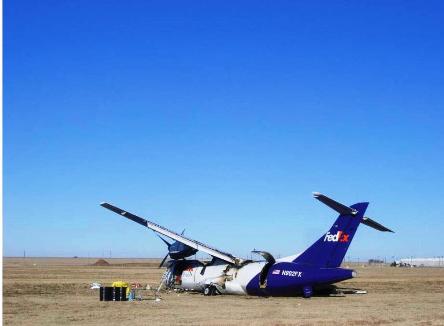The US NTSB says poor airspeed control led to an aerodynamic stall that caused the 27 January 2009 crash of an Empire Airlines ATR 42 landing at Lubbock, Texas.
Poor crew resource management, flawed decision-making and fatigue were contributing factors in the accident, which left the pilot with serious injuries, the first officer with minor injuries and the Federal Express-registered aircraft substantially damaged. The Board on 26 April issued nine safety recommendations to the US FAA related to its findings.
Empire flight 8284 had departed Ft. Worth that morning and was on an instrument approach to Lubbock at 04:37am local time when it crashed short of the runway. The aircraft had accumulated ice during the flight, but the NTSB noted that "the aircraft could have landed safely had the airspeed been maintained".
 |
|---|
©FAA |
"During the approach into Lubbock, at about 1,400ft above the ground and about 90sec from the runway, the captain indicated a flight control problem saying, 'We have no flaps,'" says the NTSB. "Although the crewmembers had been trained to perform a go-around and refer to a checklist if a flap problem occurred during an approach, the captain chose to continue the approach as he attempted to troubleshoot the flap anomaly while the first officer flew the plane."
Officials say neither pilot "adequately monitored" the airspeed from that point forward, which ultimately resulted in a stick shaker activation.
"The captain continued the unstabilized approach even though he received additional stick shaker activations and an aural 'pull up' warning from the terrain awareness and warning system (TAWS)," says the NTSB. "At that point, the plane was descending at a rate of over 2,000ft per minute."
The captain applied maximum power 17sec after the TAWS warning, after which the aircraft entered an aerodynamic stall and crashed, says the NTSB.
Safety recommendations include improving crew resource management training to "encourage first officers to more assertively voice their concerns and teach captains to develop a leadership style that supports first officer assertiveness"; prohibiting operators of pneumatic boot-equipped aircraft from dispatching into icing conditions "that are outside of those that the airplane was certified for"; improving flight simulator fidelity to "more accurately model aerodynamic degradations resulting from airframe ice accumulation"; and requiring all ATR 42s to be equipped with flap asymmetry annunciator lights.
Source: Air Transport Intelligence news










































